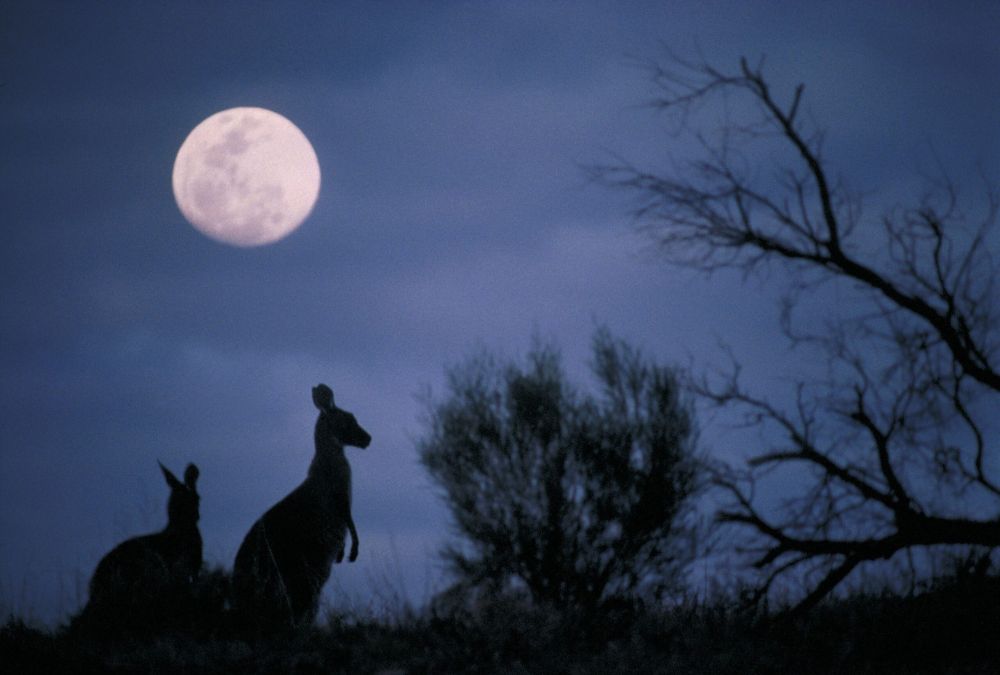Questions and inquiries welcome, my email is joshua.twining@oregonstate.edu
06.06.2025 18:09 — 👍 1 🔁 0 💬 0 📌 0
Feel free to email me at Joshua.twining@oregonstate.edu with any questions!
14.01.2025 05:22 — 👍 0 🔁 0 💬 0 📌 0
It’s got everything you could dream of - loads of fieldwork, small mammal trapping and handling, simulations to inform sampling designs and hierarchical modeling, all in the beautiful Pacific Northwest!
14.01.2025 05:22 — 👍 1 🔁 0 💬 1 📌 0
Are you looking to get a graduate degree in Fisheries, Wildlife, and Conservation Sciences? This funded MS project at OSU is focused on testing a range of non-invasive method for small mammals (enclosed camera trapping + thermal cameras mounted on drones) against SCR applied to live trapping data.
14.01.2025 05:22 — 👍 3 🔁 1 💬 1 📌 0
ahah I am Gabby. Started just a few months back.
Thank you!
13.01.2025 23:56 — 👍 1 🔁 0 💬 0 📌 0
I agree! Thanks for sharing Jess.
13.01.2025 23:44 — 👍 1 🔁 0 💬 0 📌 0
I am recruiting two funded graduate students (1 MS, 1 PhD) to join the lab and the Fisheries, Wildlife, and Conservation Sciences program at Oregon State University!
If you are into population ecology and a combination of fieldwork and modeling - then check this out!
Please share/repost widely!
13.01.2025 23:25 — 👍 19 🔁 30 💬 3 📌 1
About time. Not that I'm a fan of ranking journals, and of course there are genuine articles published in those journals, but this is just stating facts. If it's in most of MDPI/Frontiers, we can't trust it's been properly peer reviewed.
16.12.2024 11:41 — 👍 8 🔁 4 💬 0 📌 0
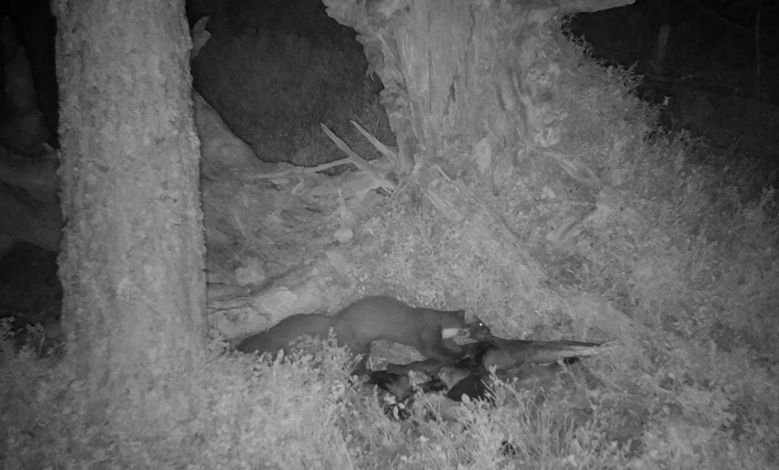
⏰New Research ⏰
We quantified the direct impact of diversionary feeding on capercaillie productivity. We show an increase in the proportion of hen with a brood in DF sites (37% -> 85%) and, as a result, a 131% increase in chicks per hen. Read more here: www.researchgate.net/publication/...
1/7
14.12.2024 16:43 — 👍 36 🔁 16 💬 3 📌 4
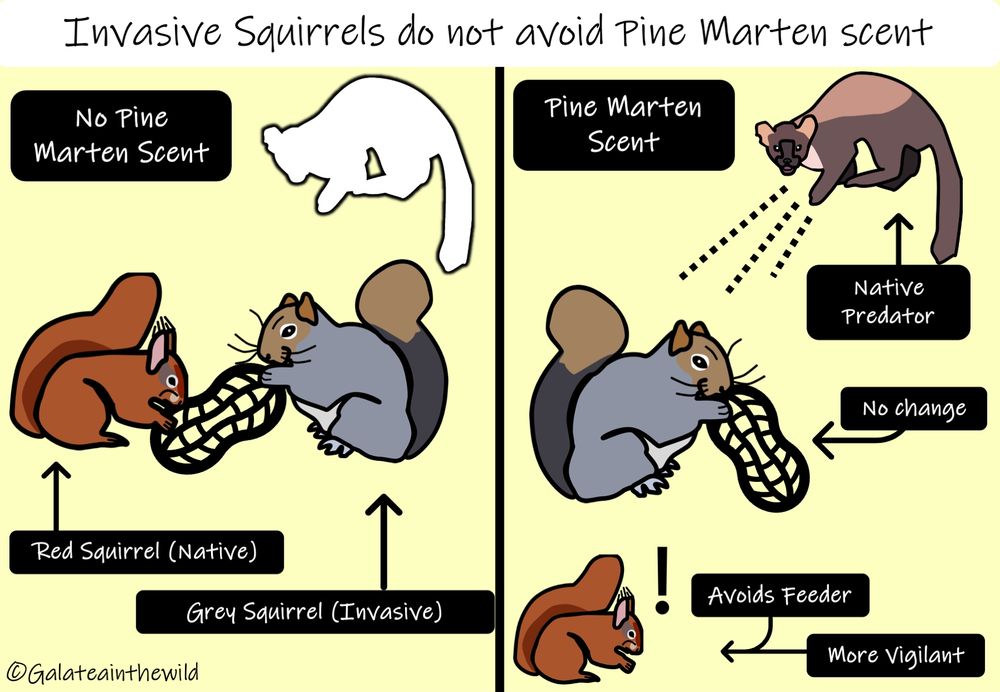
Two panel diagram. Left panel shows red (native) squirrel and grey (invasive) squirrel eating a peanut.
Right panel shows a peanut covered with Pine Marten (Native Predator) scent. The grey squirrel is eating the peanut, the red squirrel does not. Text shows it is avoiding the feeder and behaving more vigilantly.
Advent Sci-Fact 9:
Invasive squirrels do not avoid predator scent!
Grey Squirrels (Invasive in the UK) do not avoid feeders with Pine Marten scent. Native Red Squirrels visit scented feeders less frequently, for shorter visits and are more vigilant!
Paper: tinyurl.com/23u944wq
#SciComm #SciArt 🧪🌍🐿
09.12.2024 23:43 — 👍 85 🔁 19 💬 4 📌 3
Well this made my day! Thanks Galatea for the great sci comm. I love the graphic you made!
10.12.2024 05:34 — 👍 2 🔁 0 💬 1 📌 0
Forgive me, my responses were to a question about modeling plant interactions as opposed to impacts of habitat on animal abundance (the latter of which these models do - you can add any covariates that you hypothesize influence the state process (I.e. abundance) of your species of interest).
07.12.2024 21:41 — 👍 0 🔁 0 💬 0 📌 0
My inkling is that using this model with plant communities wouldn't be an optimal approach but I am uninformed on standard practices when it comes to thinking about plant interactions!
06.12.2024 20:08 — 👍 0 🔁 0 💬 1 📌 0
With mobile animals we have to contend with ubquitous issue of hetereogenity in detectability (so we explicitly address by modeling observation process.) I am niave to whether this is an issue, or even considered / worthwhile when sampling plants (which are stationary and simpler to survey?).
06.12.2024 20:06 — 👍 0 🔁 0 💬 1 📌 0
Thanks Alyssa! I think it *could* be applied to plant systems, but I imagine (I don't know) that there may be more information-rich models used in plant world which contain more info about underlying abundances (here we used detection/non-detection data, but with plants you could just count them?)
06.12.2024 20:03 — 👍 0 🔁 0 💬 2 📌 0
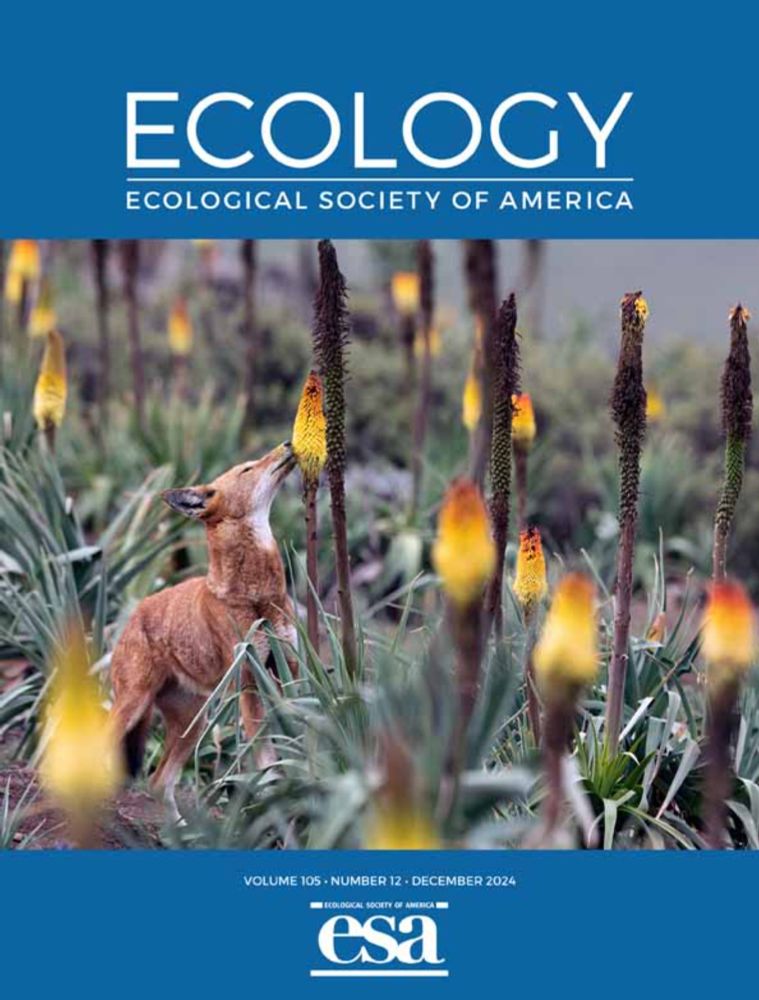
Abundance‐mediated species interactions
Species interactions shape biodiversity patterns, community assemblage, and the dynamics of wildlife populations. Ecological theory posits that the strength of interspecific interactions is fundament...
Are you interested in species interactions and how we model them?
Then this thread is for you!
Our new paper in Ecology on the role of abundance in species interactions provides new statistical tools for modelling species interactions.
shorturl.at/Sqz9m
🧵(1/13)🧵
05.12.2024 19:19 — 👍 115 🔁 37 💬 2 📌 4
Very cool model and paper!
05.12.2024 23:06 — 👍 7 🔁 2 💬 0 📌 0
I would love to join if possible!
I develop and use hierachical models for estimating population sizes, distributions, and species interactions to inform evidence-based management and conservation of wildlife populations.
05.12.2024 21:05 — 👍 1 🔁 0 💬 1 📌 0
Thanks Alexej! I hope you are well. We should catch up soon!
05.12.2024 20:21 — 👍 1 🔁 0 💬 0 📌 0
Thanks Remington!
05.12.2024 20:14 — 👍 1 🔁 0 💬 1 📌 0

There are a bunch of interaction models out there, when should you think about using this one?
Check out our flow diagram to help you decide! (13/13)
Please share widely and contact me if you can't access the paper!
05.12.2024 19:19 — 👍 9 🔁 3 💬 1 📌 0
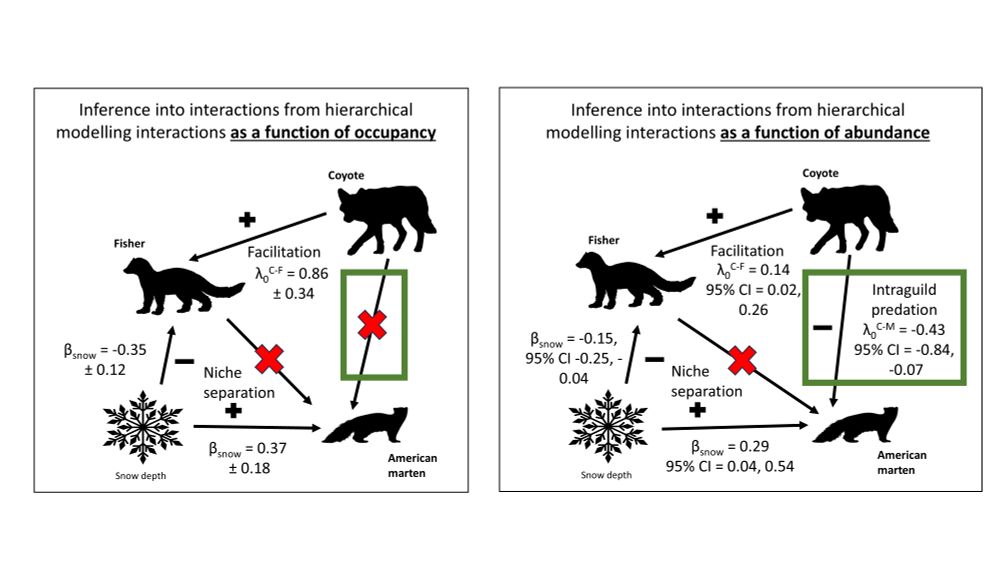
We then applied the new model to a case study of interactions between coyote, fisher, and marten in northern New York.
We detect interactions between species that we did not detect using co-occurence models! (11/13)
05.12.2024 19:19 — 👍 3 🔁 0 💬 2 📌 0
We ran a bunch of simulation studys to explore inference of modeling interactions as a function occupancy vs abundance, and to explore when, and where the abundance-mediated interaction model works well! (10/13)
05.12.2024 19:19 — 👍 1 🔁 0 💬 1 📌 0

What I think is really neat here is the variable ecological contexts of use - from intraguild interactions to parasite- or predator- mediated competition through to trophic cascades. (9/13).
05.12.2024 19:19 — 👍 3 🔁 0 💬 1 📌 0
PhD researcher at University of St Andrews 🏴 Using remote sensing and AI to study the effects of human recreation on ecological communities 🦊🦡🪶🐦⬛
(recreation ecology, statistical ecology, human-wildlife interaction, bioacoustics, camera traps, AI)
PhD student in Ecology at the University of Aberdeen researching impact of invasive species in Scotland and beyond | Statistical Ecologist |
SUPER NERC funded PhD researcher in Ecological Statistics at the @reshiveblog.bsky.social: Increasing efficiency and accessibility of wildlife monitoring data through the use of AI and remote sensing | Sub-editor at @reshiveblog.bsky.social
Lecturer in stats at Abdn Uni - https://deonroos.github.io/
PhD Student researching Leptospirosis in livestock in Madagascar 🇲🇬 and Tanzania 🇹🇿
University of Aberdeen 🏴
Research interests: Zoonotic disease, wildlife disease, and genetics 🧬🧫🦠👩🔬
PhD Researcher in Statistical Ecology @ University of St Andrews | Communications Officer @besclimate.bsky.social
Using genomics to understand host dispersal and vector-borne disease spread in metapopulations 🦠🧬🌍
NERC-funded Doctoral Focal Award. Developing the science and practice of net gain, offsetting, and nature markets.
ecologist at OSU, fan of weasels, birds, handicrafts
Ecology, PhD Candidate Univeristy of Aberdeen.
Professor of ecology, forest biodiversity, Oregon State University, Lead PI HJ Andrews NSF Long-term Ecological Research Program @uslter, https://flel.forestry.oregonstate.edu
She/Her | BSc Animal Behaviour (Hons)
🌍 Climate and nature nerd, science communicator, editor, podcaster 🦔
Hi there Bluesky! 🦋 Let's make waves. 🌊
All opinions are my own, and subject to change as science evolves and I grow 🌱
📸: Phillip Formby | WTML
Almost certainly one of the ecologists of all time.
AI/ML, biodiversity monitoring, viral emergence, open science, methodological anarchism
he/they
🧪 https://poisotlab.io/
📰 https://buttondown.email/ctrl-alt-tim
Wildlife enthusiast | Camera trap nerd | Capoeirista
I currently teach kids not to bite each other, while appreciating carnivores who do! Also working on a tiny house and being an overbearing cat mum <3
Assistant Professor @OregonState | Conservation Social Science & Human Geography approaches to human-wildlife interactions.
Reader in Conservation & PI of the Leverhulme Tropical Defaunation Hub at DICE, University of Kent
tropical biodiversity - environmental change - SE Asia - lover of Phở!
Biologist. Mountain Bird Lab PI. Climate change. Species interactions. Asst Prof @GeorgiaTech. #RapYourAbstract #MountainBirdNetwork
Quantitative ecology | Statistics | Species interactions | Population dynamics
iDiv.de Leipzig, Germany
Quantitative ecologist working mostly on modeling populations and communities of plants and critters. Queer. He/him
